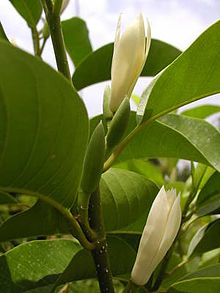Michelia alba
| White Champaca | |
|---|---|
 |
|
| Scientific classification | |
| Kingdom: | Plantae |
| (unranked): | Angiosperms |
| (unranked): | Magnoliids |
| Order: | Magnoliales |
| Family: | Magnoliaceae |
| Genus: | Magnolia |
| Subgenus: | M. subg. Yulania |
| Section: | M. sect. Michelia |
| Subsection: | M. subssect. Michelia |
| Species: | M × alba |
| Binomial name | |
|
Magnolia × alba (DC.) Figlar |
|
| Synonyms | |
|
Michelia longifolia Blume
|
|
Michelia longifolia Blume
Michelia × alba DC. (basionym)
Sampacca × longifolia (Blume) Kuntze
Magnolia × alba, also known as the white champaca, white sandalwood, or white jade orchid tree, is a flowering plant of hybrid origin that is commonly cultivated in Southeast Asia and tropical regions of East Asia. Although the exact origin is uncertain, it is considered to be a hybrid of Magnolia champaca and Magnolia montana.
The current name of white champaca derived from its local name in Indonesian language, Cempaka Putih.
The white champaca is known by various names in English including pak lan in Hawaii. Horticultural trade names used in the United States include the taxonomic synonym Michelia alba to fanciful ones such as 'white fragrant himalayan champaca'.
Names in other languages include kantil in Javanese language.
Magnolia × alba matures to 30 meters with evergreen leaves; the flowers have a count of 12 tepals.
Magnolia × alba is widely cultivated as an ornamental in Asia, particularly tropical and subtropical regions of China and Southeast Asia for the strongly fragrant flowers.
In Indonesia, the pleasantly fragrant flower is used and arranged together with Jasminum sambac as flower garland, especially wore by brides during traditional wedding ceremony.
An essential oil is extracted from the flowers. In China, where it is known as bai lan (白蘭), the flowers are used to prepare yulan tea. In traditional Chinese medicine, the flowers are used to move qi and relieve cough.
...
Wikipedia
